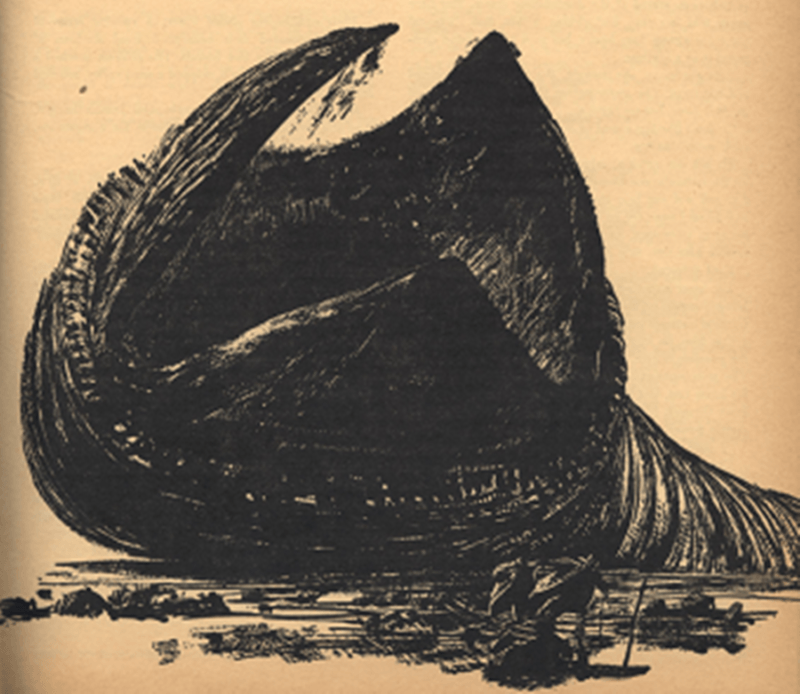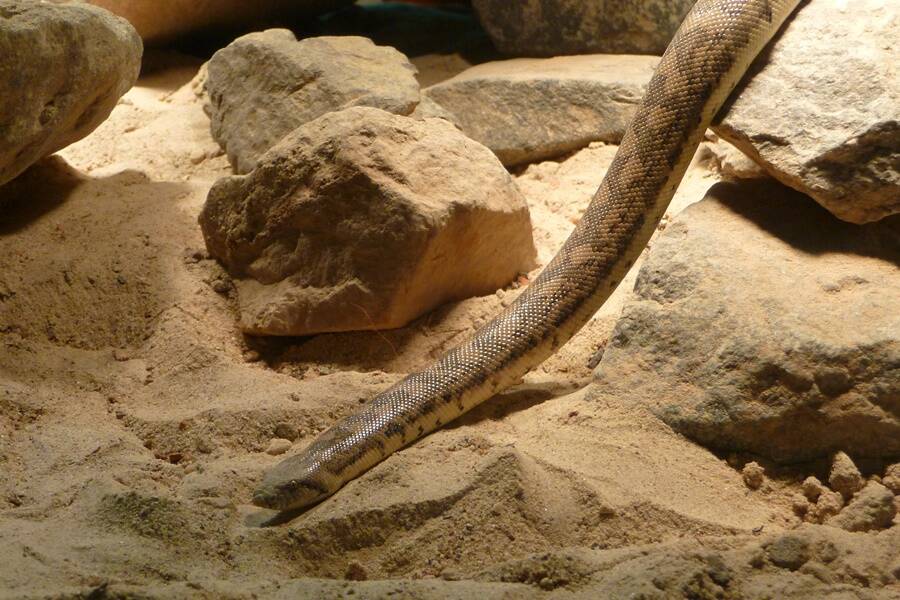For decades, cryptozoologists have searched for the Mongolian Death Worm, a five-foot monster with bright red skin that's said to slither through the desert.

Wikimedia CommonsThe Mongolian Death Worm is a monstrous cryptid said to slither through the Gobi Desert.
According to decades’ worth of alleged sightings, rumors, and legends, the Mongolian Death Worm is a long, sausage-like sandworm, dark red in color with spikes jutting out of both ends of its slithering body.
Using venomous spit strong enough to corrode metal or electric shocks powerful enough to kill an adult human, these alleged worms are said to live below the sands of the Gobi Desert. Legends still circulate about these monstrous worms but no one has ever come forward with proof of seeing them firsthand.
This is the real story behind the fabled Mongolian Death Worm.
What Is The Mongolian Death Worm, The Slithering Cryptid Of The Gobi Desert?

Wikimedia CommonsAn illustration of a fictional giant sandworm described in Frank Herbert’s sci-fi novel Dune, a creature some believe was inspired by the Mongolian Death Worm.
The Mongolian Death Worm is an infamous creature whose legend lives in secondhand accounts that have been passed down for generations.
Mongolia’s nomadic tribes call it allghoi khorkhoi, which translates roughly to intestine worm, due to its alleged resemblance to the insides of a cow. The worm-like creature with blood-red skin is said to reach up to five feet in length.
But it is nothing like your average worm. The Mongolian Death Worm is believed to possess some distinctly terrifying features.
As British biologist Karl Shuker noted of the legendary creature in The Unexplained: An Illustrated Guide to the World’s Natural And Paranormal Mysteries, the Mongolian Death Worm is believed to possess “spike-like projections at both ends” of its body.
It is also said to have formidable ways of attacking humans or other animals. The worm can purportedly spit corrosive venom or shoot out a powerful shock, electrocuting its victim.
Legend has it these terrifying creatures spend most of their time hidden underneath the sandy dunes of the Gobi Desert but that they often surface during the wetter months of June and July. If a local should happen upon this creature, they know to steer clear.
Searching For The Elusive Death Worm

Carl Bento/Australian MuseumThe giant beach worm of Australia is one example of a real-life sand-dwelling worm species.
The Mongolian Death Worm, for all the stories of its deadly projectile and grisly appearance, has to this day never been photographed. But not due to lack of effort.
Curious researchers and intrepid adventurers have combed the Gobi Desert in search of the legendary creature. Most famously, Czech cryptozoologist Ivan Mackerle, one of the foremost investigators of the mysterious animal, traveled to Mongolia three times in search of the worm, in 1990, 1992, and 2004.
Mackerle first heard of the death worm as a boy from the work of paleontologist Ivan Yefremov. In college, after he meeting a Mongolian student who believed in the worm, he became obsessed.
He combed through Mongolian literature to find more clues about the death worm and was finally granted permission by the government to conduct research there when he was in his late forties.
“Another more dangerous animal also lives in the Gobi, the allghoi khorkhoi. It resembles an intestine filled with blood, and it travels underground. Its movement can be detected from above via the waves of sand that it displaces.”
Inspired by Frank Herbert’s 1965 sci-fi novel Dune which features giant sandworms that are attracted to rhythmic vibrations, Mackerle’s expedition team tried different ways to project vibrations underground during their search for the Mongolian Death Worm.
One of the team’s contraptions was a motor-generated thumping machine. But, alas, their efforts proved fruitless and Mackerle concluded that the creature must be a myth.
While Mackerle’s expeditions failed to discover sound proof of the animal, they did provide most of the modern research material related to the Mongolian Death Worm. Subsequent expeditions to hunt down the sand beast continue today.
Is The Mongolian Death Worm Real?

Wikimedia CommonsZoologist Roy Chapman Andrews mentioned the local legend of the Mongolian Death Worm in a book about his expedition there during the 1920s.
Although the legend of the Mongolian Death Worm remains strong among locals, its existence has yet to be corroborated by physical evidence or research.
Zoologist Roy Chapman Andrews was the first western researcher to take note of the legend. He learned about the elusive sand creature from Mongolian officials before his pioneering expedition to document Mongolian wildlife. In his 1926 resulting book On the Trail of Ancient Man, Andrews wrote:
Then the Premier asked that, if it were possible, I should capture for the Mongolian government a specimen of the allergorhai-horhai…None of those present ever had seen the creature, but they all firmly believed in its existence and described it minutely…The Premier said that, although he had never seen it himself, he knew a man who had and had lived to tell the tale. Then a Cabinet Minister stated that ‘the cousin of his late wife’s sister’ had also seen it.
However, this anecdote about the Mongolian Death Worm is merely a footnote in Andrews’ book.

Animal Planet/YouTubeAn illustration of a Mongolian Death Worm, also known as olgoi-khorkhoi.
Scientists dismiss cryptids like the Chupacabra and the Florida Skunk Ape as urban legends due to lack of scientific evidence.
But there is a possibility that such a creature like the Mongolian Death Worm might exist — after all, even Jane Goodall, one of the foremost primate experts in the world, said she was open to the possibility that Bigfoot is real.
The Gobi Desert is a vast region that spans a territory of 500,000 square miles of rough terrain, making the existence of undiscovered animal species very likely.
Additionally, there are worm species that have been known to live in sand instead of soil, like the giant beach worm (Australonuphis teres) in Australia.
Moreover, in worms the circulatory system functions by absorbing oxygen through their skin and carrying it through their body, which would allow them to grow up to large sizes like the death worm’s purported five-foot length.
Yet, nobody has been able to capture photographic proof of the Mongolian Death Worm. So how did the legend come to be?
Theories Behind The Legend Of The Mongolian Death Worm

Wikimedia CommonsExperts suggest witnesses could have mistaken another animals, like this sand boa, as the legendary death worm.
There are a few possible explanations for the legend of the Mongolian Death Worm. The first theory is these accounts might actually be true but, like most stories passed orally for generations, they have become greatly exaggerated.
The English translation of “death worm” from its original Mongolian name is also misleading, and experts believe that if such a creature exists it may be a type of reptile, not a soft, wriggly worm.
Either the worm lizard, which looks like a large limbless worm that burrows underground and grows up to several feet, or a type of sand boa snake could have originally inspired the death worm lore.
No matter how the legend of the Mongolian Death Worm began, cryptid researchers have not given up hope that someday they will track it down.
Now that you’ve read about this terrifying, learn about the Native American legend of the Wendigo. Next, discover more of Earth’s most incredible cryptids.






